tow OLDSMOBILE BRAVADA 1997 Service Manual
[x] Cancel search | Manufacturer: OLDSMOBILE, Model Year: 1997, Model line: BRAVADA, Model: OLDSMOBILE BRAVADA 1997Pages: 358, PDF Size: 18.02 MB
Page 234 of 358

Operating the enge with the air cleaner off can
cause you or others to be burned. The air cleaner
not only cleans the air, it stops flame
if the engine
backfires. If it isnât there, and the engine
backfires, you could be burned. Donât drive with
it
off, and be careful working on the engine with
the air cleaner
off.
NOTICE:
If the air cleaner is off, a backfire can cause a
damaging engine fire. And, dirt can easily get
into your engine, which will damage it. Always
have the air cleaner
in place when youâre driving.
Automatic Transmission Fluid
When to Check and Change
A good time to check your automatic transmission fluid
level is when the engine oil is changed.
Change both the
fluid and filter every 50,000 miles
(83 000 km) if the vehicle is mainly driven under one or
more
of these conditions:
In heavy city traffic where the outside temperature
regularly reaches
90°F (32°C) or higher.
In hilly or mountainous terrain.
0 When doing frequent trailer towing.
0 Uses such as found in taxi, police or delivery service.
If you do not use your vehicle under any of these
conditions, the fluid and filter do not require changing.
See âScheduled Maintenance Servicesâ
in the Index.
6-14
ProCarManuals.com
Page 236 of 358

Checking Transmission Fluid Cold
A cold check is made after the vehicle has been sitting
for eight hours or more
with the engine off and is used
only as a reference. Let the engine run at idle for five
minutes if outside temperatures are 50°F
(10°C) or
more. If it's colder than
50°F (IO'C), you may have to
idle the engine longer. Should the fluid level be
low
during a cold check, you must perform a hot check
before adding fluid. This will give
you a more accurate
reading
of the fluid level.
Checking the Fluid Hot or Cold
0
0
0
Park your vehicle on a level place. Keep the
engine running.
With the parking brake applied, place the shift lever
in PARK (P).
With your foot on the brake pedal, move the shift
lever through each gear range, pausing for about
three seconds
in each range. Then, position the shift
lever in
PARK (P).
Let the engine run at idle for three minutes or more. Then, without shutting
off the engine, follow these steps:
1. Flip
the handle up and then pull out the dipstick and
wipe
it with a clean rag or paper towel.
2. Push it back in all the way, wait three seconds and
then
pull it back out again.
6-16
ProCarManuals.com
Page 258 of 358
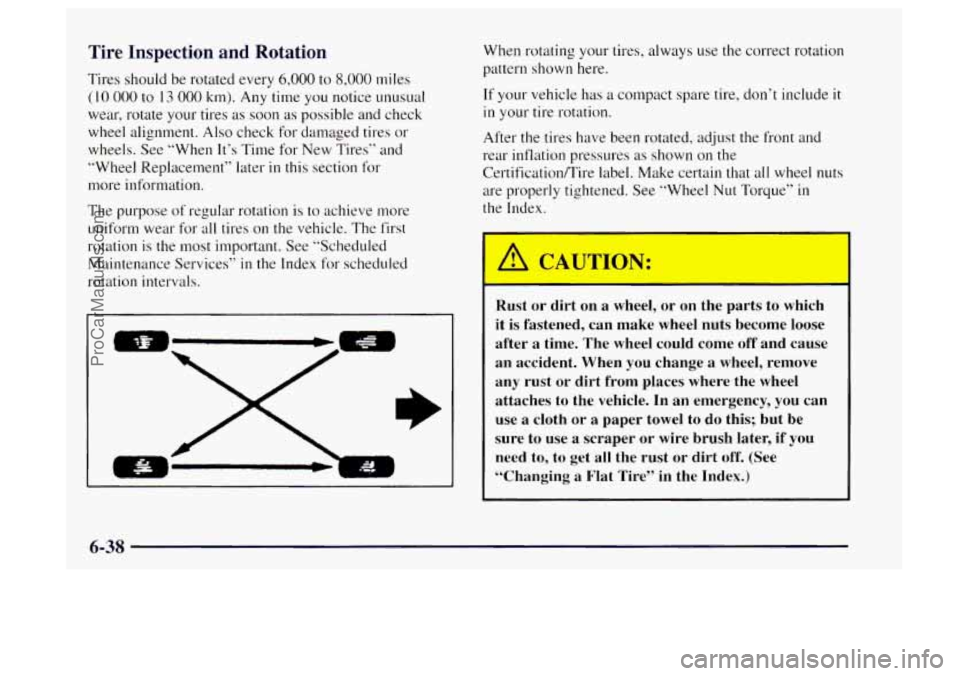
Tire Inspection and Rotation
Tires should be rotated every 6,000 to 8,000 miles
( 10 000 to 13 000 km). Any time you notice unusual
wear, rotate your tires
as soon as possible and check
wheel alignment. Also check for damaged tires or
wheels. See âWhen Itâs Time for New Tiresâ and
âWheel Replacementâ later
in this section for
more information.
The purpose of regular rotation
is to achieve more
uniform wear for all tires on the vehicle. The first
rotation
is the most important. See âScheduled
Maintenance Servicesâ
in the Index for scheduled
rotation intervals. When rotating your tires, always
use the correct rotation
pattern shown here.
If your vehicle has a compact spare
tire, donât include it
in your tire rotation.
After the tires have been rotated, adjust the front and
rear inflation pressures
as shown on the
Certificationmire label. Make certain that all wheel nuts
are properly tightened. See
âWheel Nut Toraueâ in
the Index.
Rust or dirt on a wheel, or on the parts to which
it is fastened, can make wheel nuts become loose
after a time. The wheel could come off and cause
an accident. When you change a wheel, remove
any rust or dirt from places where the wheel
attaches to the vehicle. In an emergency, you can
use a cloth or a paper towel to do this; but be
sure to use a scraper or wire brush later,
if you
need to, to get all the rust or dirt off. (See
âChanging a Flat Tireâ in the Index.)
6-38
ProCarManuals.com
Page 265 of 358
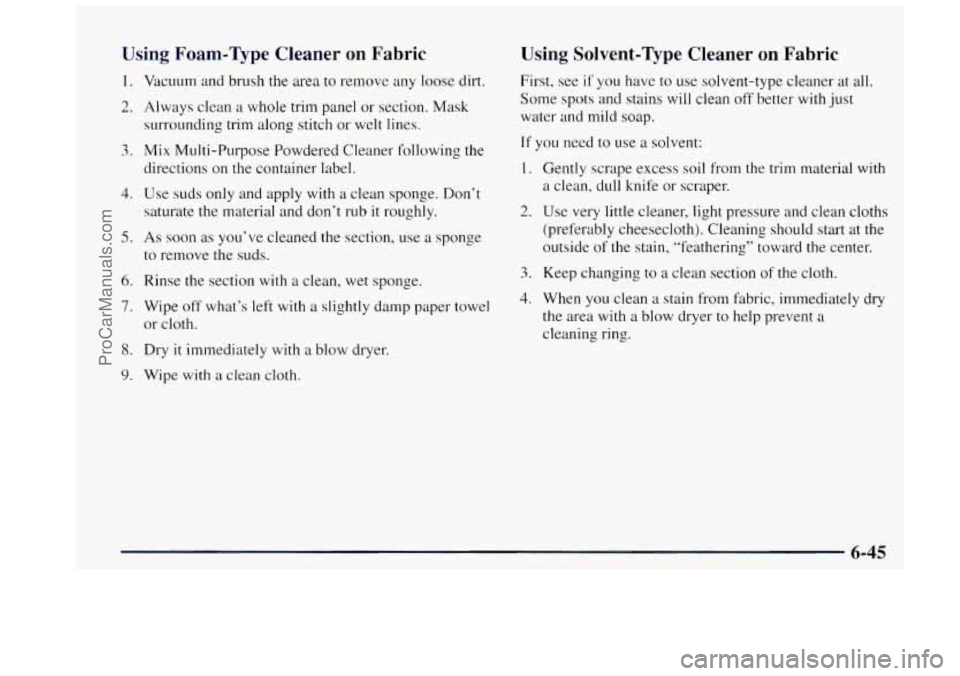
Using Foam-Type Cleaner on Fabric
1.
2.
3.
4.
5.
6.
7.
8.
9.
Vacuum and brush the area to remove any loose dirt.
Always clean a whole trim panel or section. Mask
surrounding trim along stitch
01- welt lines.
Mix Multi-Purpose Powdered Cleaner following the
directions on the container label.
Use suds only and apply with
a clean sponge. Donât
saturate the material and donât rub it roughly.
As soon as youâve cleaned the section, use a sponge
to remove the suds.
Rinse the section with a clean, wet sponge.
Wipe off whatâs left with
a slightly damp paper towel
or cloth.
Dry
it immediately with a blow dryer.
Wipe with
a clean cloth.
Using Solvent-Qpe Cleaner on Fabric
First, see if you have to use solvent-type cleaner at all.
Some spots and stains
will clean off better with just
water and mild
soap.
If you need to use a solvent:
1.
2.
3.
4.
Gently scrape excess soil from the trim material with
a clean, dull knife or scraper.
Use very little cleaner, light pressure and clean cloths
(preferably cheesecloth). Cleaning should start at the
outside of the stain, âfeatheringâ toward the center.
Keep changing to
a clean section of the cloth.
When you clean
a stain from fabric, immediately dry
the area with a blow dryer to help prevent
a
cleaning ring.
6-45
ProCarManuals.com
Page 268 of 358
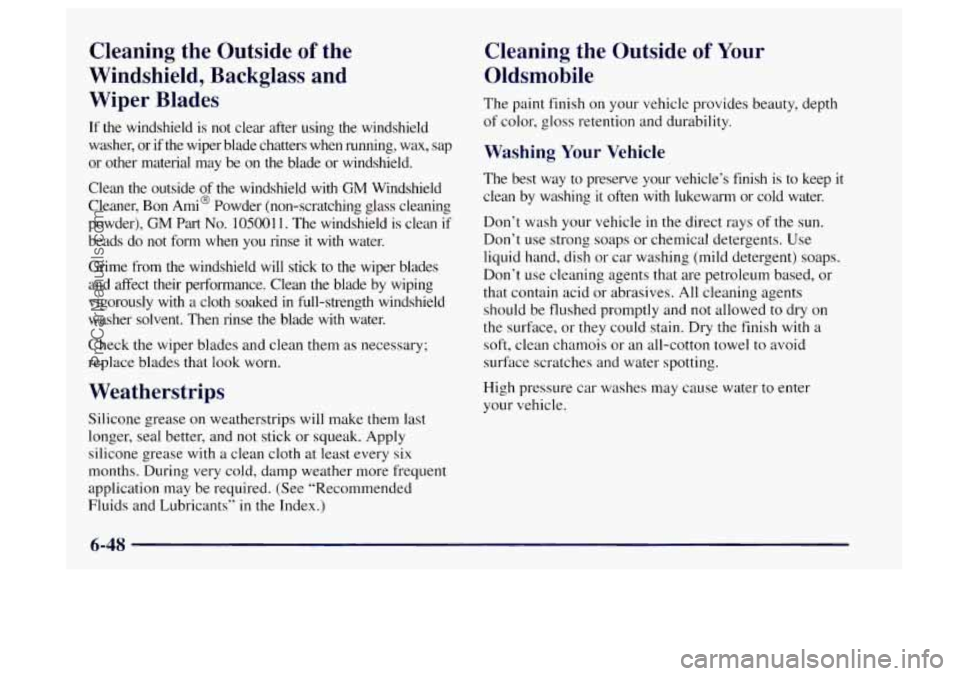
Cleaning the Outside of the
Windshield, Backglass and
Wiper Blades
If the windshield is not clear after using the windshield
washer, or if the wiper blade chatters when running, wax, sap
or other material may be on the blade or windshield.
Clean the outside of
the windshield with GM Windshield
Cleaner, Bon Ami@ Powder (non-scratching glass cleaning
powder), GM Part
No. 1050011. The windshield is clean if
beads do not form when you rinse it with water.
Grime from the windshield will stick to the wiper blades
and
affect their performance. Clean the blade by wiping
vigorously with
a cloth soaked in full-strength windshield
washer solvent. Then rinse
the blade with water.
Check the wiper blades and clean them as necessary;
replace blades that look worn.
Weatherstrips
Silicone grease on weatherstrips will make them last
longer, seal better, and not stick or squeak. Apply
silicone grease with
a clean cloth at least every six
months. During very cold, damp weather more frequent
application may be required. (See âRecommended
Fluids and Lubricantsâ
in the Index.)
Cleaning the Outside of Your
Oldsmobile
The paint finish on your vehicle provides beauty, depth
of color, gloss retention and durability.
Washing Your Vehicle
The best way to preserve your vehicleâs finish is to keep it
clean by washing it often with lukewarm or cold water.
Donât wash your vehicle in the direct rays of the sun.
Donât use strong soaps or chemical detergents. Use
liquid hand, dish or car washing (mild detergent) soaps.
Donât use cleaning agents that are petroleum based, or
that contain acid or abrasives. All cleaning agents
should be flushed promptly and not allowed to dry on
the surface, or
they could stain. Dry the finish with a
soft, clean chamois or an all-cotton towel to avoid
surface scratches and water spotting.
High pressure car washes may cause water to enter
your vehicle.
ProCarManuals.com
Page 270 of 358
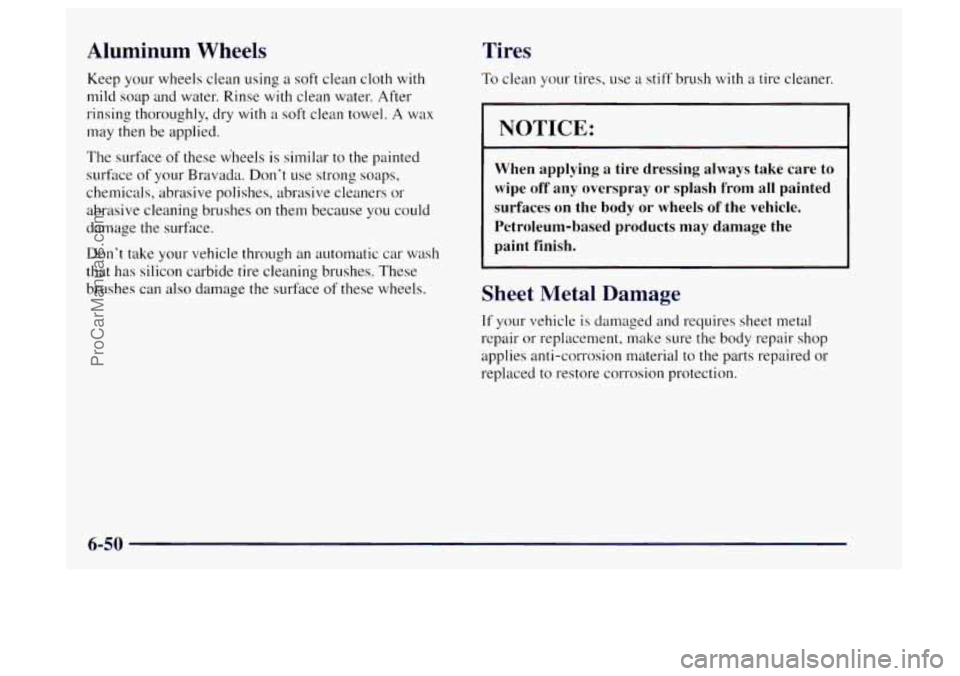
Aluminum Wheels
Keep your wheels clean using a soft clean cloth with
mild
soap and water. Rinse with clean water. After
rinsing thoroughly, dry with a
soft clean towel. A wax
may then be applied.
The surface
of these wheels is similar to the painted
surface of your Bravada. Donât use strong soaps,
chemicals, abrasive polishes, abrasive cleaners
or
abrasive cleaning brushes on them because you could
damage the surface.
Donât take your vehicle through an automatic car wash
that has silicon carbide tire cleaning brushes. These
brushes can also damage the surface
of these wheels.
Tires
To clean your tires, use a stiff brush with a tire cleaner.
NOTICE:
When applying a tire dressing always take care to
wipe off any overspray or splash from all painted
surfaces
on the body or wheels of the vehicle.
Petroleum-based products may damage the
paint finish.
Sheet Metal Damage
If your vehicle is damaged and requires sheet metal
repair or replacement, make sure the body repair shop
applies anti-corrosion material to the parts repaired or
replaced to restore corrosion protection.
6-50
ProCarManuals.com
Page 287 of 358

Maintenance Schedule
I Short TriplCity Definition I
Follow the Short Trip/City Maintenance Schedule if any
one of these conditions
is true for your vehicle:
0
0
0
0
0
Most trips are less than 5 to 10 miles (8 to 16 km).
This is particularly important when outside
temperatures are below freezing.
Most trips include extensive idling (such
as frequent
driving in stop-and-go traffic).
You operate your vehicle in dusty areas or
off-road frequently.
You frequently tow a trailer or use a carrier on top of
your vehicle.
If the vehicle is used for delivery service, police, taxi
or other commercial application.
One
of the reasons you should follow this schedule if
you operate your vehicle under any of these conditions
is that these conditions cause engine oil to break
down soonez
Short TripKity Intervals
Every 3,000 Miles (5 000 km): Engine Oil and Filter
Change (or
3 months, whichever occurs first). Chassis
Lubrication (or
3 months, whichever occurs first). Drive
Axle Service (or
3 months, whichever occurs first).
Every 6,000 Miles (10 000 km): Tire Rotation.
Every 15,000 Miles (25 000 km): Air Cleaner Filter
Inspection, if driving in dusty conditions.
Every 30,000 Miles (50 000 km): Air Cleaner Filter
Replacement. Fuel Filter Replacement.
Every 50,000 Miles (83 000 km): Automatic
Transmission Service (severe conditions only).
Every 60,000 Miles (100 000 km): Engine Accessory
Drive Belt Inspection. Fuel
Tank, Cap and Lines Inspection.
Every 100,000 Miles (166 000 km): Spark Plug Wire
Inspection. Spark Plug Replacement. Positive
Crankcase Ventilation (PCV) Valve Inspection.
Every 150,000 Miles (240 000 km): Cooling System
Service (or every
60 months, whichever occurs first).
These intervals only sunzmarize maintenance services.
Be sure
to follow the complete maintenance schedule on
the following pages.
RP / -3
ProCarManuals.com
Page 288 of 358

Maintenance Schedule
Long Tripmighway Definition - -
Follow this maintenance schedule only if none of the
conditions from the Short TripKity Maintenance
Schedule is true.
Do not use this schedule if the vehicle
is used for trailer towing, driven
in a dusty area or used
off paved roads. Use the Short Trip/City schedule for
these conditions.
Driving
CI vehicle with c~~fidly cuarlned engine under
Iliglzwny conditions
causes engine oil to br-ecrk
down slovver:
vong Trip/Highway Intervals
Every 7,500 Miles (12 500 km): Engine Oil and Filter
Change (or every
12 months, whichever occurs first).
Chassis Lubrication (or every
12 months, whichever
occurs first). Drive Axle Service. Tire Rotation.
Every 30,000 Miles (50 000 km): Fuel Filter
Replacement. Air Cleaner Filter Replacement.
Every 50,000 Miles (83 000 km): Automatic
Transmission Service (severe conditions only).
Every 60,000 Miles (100 000 km): Engine
Accessory Drive Belt Inspection. Fuel Tank,
Cap and Lines Inspection.
Every 100,000 Miles (166 000 km): Spark Plug Wire
Inspection. Spark Plug Replacement. Positive
Crankcase Ventilation (PCV) Valve Inspection.
Every 150,000 Miles (240 000 km): Cooling System
Service (or every
60 months, whichever occurs first).
These interwls odv s~.mmar-ize nminteneu?ce services.
Be ,wre to~follorv the c.ompletr rmintenclnce .schd~tle OR
the*fi)llmving pages.
7-6
ProCarManuals.com
Page 289 of 358
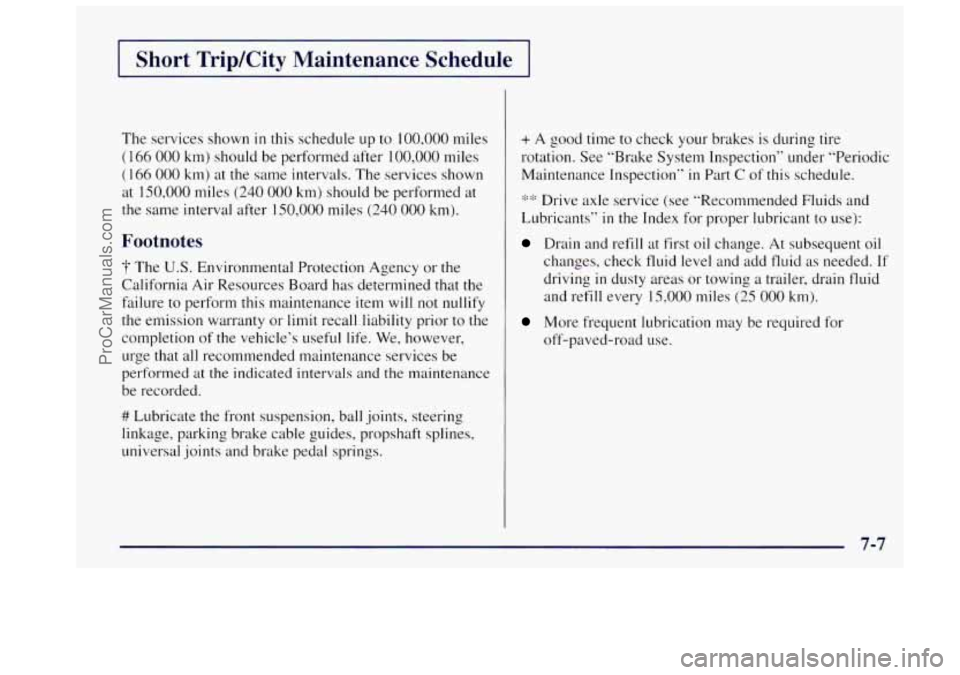
Short Trip/City Maintenance Schedule
The services shown in this schedule up to 100,000 miles
( 166 000 kmj should be performed after 100,000 miles
(166 000 kmj at the same intervals. The services shown
at
150,000 miles (240 000 km) should be performed at
the same interval after
150,000 miles (240 000 km).
Footnotes
7 The U.S. Environmental Protection Agency or the
California Air Resources Board has determined that the
failure to perform this maintenance item will
not nullify
the emission warranty or limit recall liability prior to the
completion of the vehicleâs useful life. We, however,
urge that all recommended maintenance services be
performed at the indicated intervals and the maintenance
be recorded.
## Lubricate the front suspension, ball joints, steering
linkage, parking brake cable guides, propshaft splines,
universal joints and brake pedal springs.
+ A good time to check your brakes is during tire
rotation. See âBrake System Inspectionâ under âPeriodic
Maintenance Inspectionââ in Part
C of this schedule.
âbâk Drive axle service (see âRecommended Fluids and
Lubricantsâ
in the Index for proper lubricant to usej:
Drain and refill at first oil change. At subsequent oil
changes, check fluid level and add fluid
as needed. If
driving in dusty areas or towing a trailer, drain fluid
and refill every
15,000 miles (25 000 km).
More frequent lubrication may be required for
off-paved-road use.
7-7
ProCarManuals.com
Page 298 of 358

I Short TripKity Maintenance Schedule I
48,000 Miles (80 000 km)
Change engine oil and filter (or every
3 months, whichever occurs first).
An Emission Control Service.
0 Lubricate chassis components (or every
3 months, whichever occurs first).
(See footnote
#.)
0 Check readfront axle fluid level and add fluid
as needed. Check constant velocity joints and
axle seals for leaking. (See footnote
**.)
0 Rotate tires. See âTire Inspection and
Rotationâ in the Index for proper rotation
pattern and additional information.
(See footnote
+.)
50,000 Miles (83 000 km)
0 Change automatic transmission fl~ Jid and
filter
if the vehicle is mainly driven under
one
or more of these conditions:
- In heavy city traffic where the outside
temperature regularly reaches
90â F
(32°C) or higher.
- In hilly or mountainous terrain.
- When doing frequent trailer towing.
- Uses such as found in taxi, police or
delivery service.
If you do uot USP yo~dr vehicle msier snl>* qf thescr
cwnditior?s, tlle,fluicl andfiltc!I-do
not respire changing.
DATE I ACTUAL MILEAGE I SERVICED BY I
~~ ~~~
7-16
ProCarManuals.com